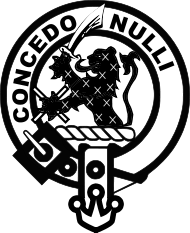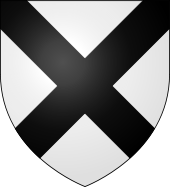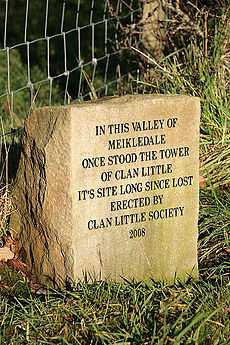- Clan Little
-
Clan Little is a Scottish clan of the Borders. The clan does not currently have a chief and is therefore considered an armigerous clan.
Clan Little Crest badge 
Crest: A demi lion Sable powdered with saltires Argent, armed Gules, in dexter paw a cutlass Proper and in sinister a saltire Argent Motto: Concedo nulli or Fidei coticula crux Profile Region Borders Chief Clan Little has no chief, and is an armigerous clan 
Arms of the last Chief of Clan Little Last Chief: Little of Meikledale Historic seat Meikledale Contents
History
Origins of the Clan
According to Black, Little is a descriptive name and was originally written in latin documents as parvus meaning little or small.[1] Black goes on to note that Hugo parvus was a clerical regis in the time of William the Lion and Hugo parvus was burgess of Dundee in about 1202.[1] Given that the name is descriptive it is impossible to find any clear origin of the Little name in Scotland.[2]
According to Dr. Johnnie C (Crawford) Little,[3] the Littles are descended from Richard le Lytle, himself a descendant of Hugh d'Avranches, 1st Earl of Chester, the nephew of William the Conqueror. The Littles trace their male line through the Dukes of Normandy to Ingjald, the last Yngling Peace King of Uppsala, Sweden who ruled in the mid 7th century AD.[4][self-published source?]
In the 12th century David I King of Scots appointed Walter fitz Alan, an Anglo-Norman from Shropshire, as High Steward of Scotland. In his capacity as Steward, Walter granted lands at Cairntable, Ayrshire to Alan Little, a former neighbour on the Shropshire-Cheshire border.[5] By 1300 the Littles had settled in Dumfriesshire where Nichol Little was recorded as Conservator of the Peace for Lochmabenston in the Scottish West March of the Anglo-Scottish border.[6][self-published source?]
Between 1406 and 1420 Simon Lytil was granted tenure of Meikledale, Sorbie and Kirktoun in Ewesdale, Dumfriesshire by the then regent, Robert Stewart, 1st Duke of Albany. The grant was confirmed in 1420 when James I returned from his captivity in England. Simon Little, lst Laird of Meikledale, is therefore considered to be the first chief of the name.[7]
Wars of Scottish Independence
About the time of Alan Little's grant of land at Cairntable, Walter the Steward granted lands near Kilmarnock, Ayrshire to Richard le Waleys, also of Shropshire. This Richard was the g-g-grandfather of Sir William Wallace, one of the main leaders in the early Wars of Scottish Independence. Sir William's sister married a Little and her son, Edward, became a trusted lieutenant of his. Edward Little is commemorated in Blind Harry the Minstrel's poem The Wallace: "And Edward Littil his sisters sone so der / Full wel graithit in till thar armour cler".[8]
15th Century
Members of the Little clan became established in Ewesdale, Eskdale and Wauchopedale. Following the House of Douglas' forfeiture as tenants-in-chief,following the Battle of Arkinholm in 1455, the Eskdale-Ewesdale lands passed to the Maxwell clan and the Little's allegiance subsequently changed.[9]
16th Century
By the start of the 16th century Clan Armstrong had risen to power such that it was reputed in 1528 that they could muster 3,000 horsemen, Littles amongst them. Their leader, Johnnie Armstrong of Gilnockie, posed a threat to King James V who arranged in 1530 to meet him at Caerlanrig. The Armstrong retinue was surprised by the king's men and 33 Armstrongs, Littles, Elliots and Irvings, including Johnnie, were hanged on the spot.[10] In 1568 over 100 Littles rode with Batysons, Armstrongs, Glendinnings and Thompsons on John Maxwell, Earl of Morton's raid on Stirling. Family tradition has it that the Littles returned with many more horses then they set out with. They were pardoned in 1585.[6]
17th Century
The Union of the Crowns in 1603 meant that James I of England and VI of Scots no longer had a need for strong men in his 'Middle Shires'. The Border reivers had become a nuisance to the king and efforts were made to disband them using fire, noose and sword. Many Borderers were transported to Ireland and others fled into north-west Cumberland.[10] At this time Simon Little of Meikledale was chief, followed by his son, Thomas, and grandson, David, chief in 1670.
18th Century
David Little was the last Little to be Laird of Meikledale. Following the Pacification of the Border the lairdship passed to Thomas Beattie and David was given work as a groom at Windsor Castle. He had two sons: Simon Little of Nittyholm who had seven daughters, and Matthew (William?) Little who lived in Reading and 'went to sea' in 1745. Any descendants of Matthew have yet to be traced.
Throughout the 18th and 19th centuries Littles migrated throughout the United Kingdom and to North America, Australia and New Zealand.
Clan Symbols
Arms
The arms of the Lairds of Meikledale were: sable a saltire argent[11][12], also sable a saltire engrailed argent.[10]
The Clan Little Society (Scotland & Worldwide) is an armigerous society, having its own arms granted by Lord Lyon King of Arms in 1997.[13]Crest badge
The Clan Crest badge is made up of the last chief, The Little of Meikledale's heraldic crest and motto:
- Meikledale's motto: Concedo nulli,[11][12] or Fidei coticula crux.[11][12]
- Meikledale's crest: A demi lion Sable powdered with saltires Argent, armed Gules, in dexter paw a cutlass Proper and in sinister a saltire Argent.[11][12]
Mottoes
Concedo Nulli - I yield to no-one my trust.[11]
Magnum in Parvo - Great in little.[10]
Fidei Coticula Crux - The cross is the touchstone of faith.[11]
Tartan
Members of the Clan Little Society may wear the Little of Morton Rigg tartan. This sett was designed by Dr Johnnie Little of Morton Rigg, then clan guardian, in 1991. It incorporates elements of the Wallace tartan (alluding to the historical connection to Sir William Wallace) and the Shepherd tartan.[14] 19th century photographs of Littles and other Borderers regularly show them in clothing and plaids of the simple, black and white Shepherd sett. In contrast to National Scottish Dress conventions Border clansmen occasionally wear non-matching plaids. For example, it is acceptable to wear trews in the Little of Morton Rigg tartan and a plaid in the Shepherd tartan.
Livery Colours
Black and white, taken from the Lairds of Meikledale's arms.[citation needed]
Clan Plant
Heather.[citation needed]
Clan March
The Reivers of Meikledale,[citation needed] a 2/4 march written for the clan in 1993 by John Mason MBE.
See also
Little (surname)
References
- ^ a b George F. Black; The Surnames of Scotland; 1946 New York Library; 1999 Birlinn Limited, Edinburgh; pp. 432
- ^ The Standing Council of Scottish Chiefs website page: Clan Little
- ^ Little, J. C. (1988). A thousand years: The Littles and their forebears. The Scottish Genealogist, 35(2), 45-62.
- ^ J.C. Little (2003), Westerkirk Parish Kirk.
- ^ Chalmers, G. (1800). A histrical and topographical account of North Britain from the most ancient to the present times, with a dictionary of places chorographical and philological (vol. 6).
- ^ a b J.C. Little (2003), Westerkirk Parish Kirk.
- ^ R.B. Armstrong (1883), The history of Liddesdale, Eskdale ... and the Debateable Land.
- ^ Blind Harry the Minstrel (15th C), Wallace.
- ^ Deduced from Acta Parliamentorium Jacobi VI (1585).
- ^ a b c d G. McDonald Fraser (1986), The steel bonnets.
- ^ a b c d e f myclan.com/clans/Little
- ^ a b c d Scottish arms : being a collection of armorial bearings, A.D. 1370-1678 by R. R. Stodart, 1881. pp. 243
- ^ http://www.nwrain.net/~little/heraldry.htm retrieved 18/02/11
- ^ http://www.tartanregister.gov.uk/tartanDetails.aspx?ref=2127 retrieved 18/02/11
External links
- Clan Little Society (Scotland and Worldwide): http://www.nwrain.net/~little/index.htm
- Clan Little Society (North America): http://clanlittlesna.com/
- The Scottish Register of Tartans: http://www.tartanregister.gov.uk/search.aspx
Scottish clans Clans with chiefs Agnew · Anstruther · Arbuthnott · Arthur · Bannerman · Barclay · Borthwick · Boyd · Boyle · Brodie · Broun · Bruce · Buchan · Burnett · Cameron · Campbell · Carmichael · Carnegie · Cathcart · Charteris · Chattan · Chisholm · Cochrane · Colquhoun · Colville · Cranstoun · Crichton · Cumming · Darroch · Davidson · Dewar · Drummond · Dunbar · Dundas · Durie · Elliot · Elphinstone · Erskine · Farquharson · Fergusson · Forbes · Forsyth · Fraser · Fraser of Lovat · Gayre · Gordon · Graham · Grant · Gregor · Grierson · Guthrie · Haig · Haldane · Hamilton · Hannay · Hay · Henderson · Home · Hope · Hunter · Irvine · Jardine · Johnstone · Keith · Kennedy · Kerr · Kincaid · Lamont · Leask · Lennox · Leslie · Lindsay · Lockhart · Lumsden · Lyon · MacAlister · MacBain · MacDonald · Macdonald of Clanranald · MacDonald of Keppoch · Macdonald of Sleat · MacDonell of Glengarry · MacDougall · Macdowall · MacIntyre · Mackay · Mackenzie · Mackinnon · Mackintosh · Maclachlan · Maclaine of Lochbuie · MacLaren · MacLea (Livingstone) · Maclean · MacLennan · MacLeod · MacLeod of Lewis · MacMillan · Macnab · Macnaghten · MacNeacail · MacNeil · Macpherson · MacTavish · MacThomas · Maitland · Makgill · Malcolm (MacCallum) · Mar · Marjoribanks · Matheson · Menzies · Moffat · Moncreiffe · Montgomery · Morrison · Munro · Murray · Napier · Nesbitt · Nicolson · Ogilvy · Oliphant · Primrose · Ramsay · Rattray · Riddell · Robertson · Rollo · Rose · Ross · Ruthven · Sandilands · Scott · Scrymgeour · Sempill · Shaw · Sinclair · Skene · Spens · Stirling · Strange · Stuart of Bute · Sutherland · Swinton · Trotter · Urquhart · Wallace · Wedderburn · Wemyss · Wood ·
Armigerous clans Abercromby · Abernethy · Adair · Adam · Aikenhead · Ainslie · Aiton · Allardice · Anderson · Armstrong · Arnott · Auchinleck · Baillie · Baird · Balfour · Bannatyne · Baxter · Bell · Belshes · Bethune · Beveridge · Binning · Bissett · Blackadder · Blackstock · Blair · Blane · Blyth · Boswell · Brisbane · Buchanan · Butter · Byres · Cairns · Calder · Caldwell · Callender · Campbell of Breadalbane · Campbell of Cawdor · Carruthers · Cheyne · Chalmers · Clelland · Clephane · Cockburn · Congilton · Craig · Crawford · Crosbie · Cunningham · Dalmahoy · Dalrymple · Dalzell · Dennistoun · Don · Douglas · Duncan · Dunlop · Edmonstone · Fairlie · Falconer · Fenton · Fleming · Fletcher · Forrester · Fotheringham · Fullarton · Galbraith · Galloway · Gardyne · Gartshore · Ged · Gibsone · Gladstains · Glas · Glen · Glendinning · Gray · Gunn · Haliburton · Halkerston · Halket · Hepburn · Heron · Herries · Hogg · Hopkirk · Horsburgh · Houston · Hutton · Inglis · Innes · Kelly · Kinloch · Kinnaird · Kinnear · Kinninmont · Kirkcaldy · Kirkpatrick · Laing · Lammie · Langlands · Learmonth · Little · Logan · Logie · Lundin · Lyle · MacAulay · Macbrayne · MacDuff · MacEwen · MacFarlane · Macfie · Macgillivray · MacInnes · MacIver · Mackie · MacLellan · Macquarrie · Macqueen · Macrae · Masterton · Maule · Maxton · Maxwell · McCorquodale · McCulloch · McKerrell · Meldrum · Melville · Mercer · Middleton · Moncur · Monteith · Monypenny · Mouat · Moubray · Mow · Muir · Murray of Atholl · Nairn · Nevoy · Newlands · Newton · Norvel · Ochterlony · Orrock · Paisley · Paterson · Pennycook · Pentland · Peter · Pitblado · Pitcairn · Pollock · Polwarth · Porterfield · Preston · Pringle · Purves · Rait · Ralston · Renton · Roberton · Rossie · Russell · Rutherford · Schaw · Seton · Skirving · Somerville · Spalding · Spottiswood · Stewart · Stewart of Appin · Strachan · Straiton · Strange · Sydserf · Symmers · Tailyour · Tait · Tennant · Troup · Turnbull · Tweedie · Udny · Vans · Walkinshaw · Wardlaw · Watson · Wauchope · Weir · Whitefoord · Whitelaw · Wishart · Young
Culture and society Scotland · Clan chief · Septs · Clan badge · Clan crest · Clan battles · Tartan · Bagpipes · Clearances · Kilt · Manrent · The Highlands · Battle of Culloden · Highland games · Border Reivers · Scottish heraldry · Scottish surnames
Categories:- Scottish clans
- Surnames
- Borders
Wikimedia Foundation. 2010.

